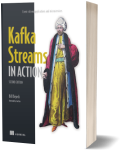Kafka Streams in Action: Event-driven applications and microservices Edition: 2
Programming
Book Details
Book Title
Kafka Streams in Action: Event-driven applications and microservices Edition: 2
Author
Bill Bejeck
Publisher
Manning
Publication Date
2024
ISBN
9781617298684
Number of Pages
506
Language
English
Format
File Size
6.83MB
Subject
Computers>Programming: Libraries API
Table of Contents
- Kafka Streams in Action
- Praise for the first edition
- brief contents
- contents
- foreword
- preface
- acknowledgments
- about this book
- about the author
- about the cover illustration
- Part 1
- Chapter 1. Welcome to the Kafka event streaming platform
- 1.1 Event streaming
- 1.2 What is an event?
- 1.3 An event stream example
- 1.4 Introducing the Apache Kafka event streaming platform
- 1.5 A concrete example of applying the Kafka event streaming platform
- Summary
- Chapter 2. Kafka brokers
- 2.1 Introducing Kafka brokers
- 2.2 Produce requests
- 2.3 Fetch requests
- 2.4 Topics and partitions
- 2.5 Sending your first messages
- 2.6 Segments
- 2.7 Tiered storage
- 2.8 Cluster metadata
- 2.9 Leaders and followers
- 2.10 Checking for a healthy broker
- Summary
- Part 2
- Chapter 3. Schema Registry
- 3.1 Objects
- 3.2 What is a schema, and why do you need one?
- 3.3 Subject name strategies
- 3.4 Schema compatibility
- 3.5 Schema references
- 3.6 Schema references and multiple events per topic
- 3.7 Schema Registry (de)serializers
- 3.8 Serialization without Schema Registry
- Summary
- Chapter 4. Kafka clients
- 4.1 Introducing Kafka clients
- 4.2 Producing records with the KafkaProducer
- 4.3 Consuming records with the KafkaConsumer
- 4.4 Exactly-once delivery in Kafka
- 4.5 Using the Admin API for programmatic topic management
- 4.6 Handling multiple event types in a single topic
- Summary
- Chapter 5. Kafka Connect
- 5.1 An introduction to Kafka Connect
- 5.2 Integrating external applications into Kafka
- 5.3 Getting started with Kafka Connect
- 5.4 Applying Single Message Transforms
- 5.5 Adding a sink connector
- 5.6 Building and deploying your own connector
- Summary
- Part 3
- Chapter 6. Developing Kafka Streams
- 6.1 A look at Kafka Streams
- 6.2 Kafka Streams DSL
- 6.3 Hello World for Kafka Streams
- 6.4 Masking credit card numbers and tracking purchase rewards in a retail sales setting
- 6.5 Interactive development
- 6.6 Choosing which events to process
- Summary
- Chapter 7. Streams and state
- 7.1 Stateful vs. stateless
- 7.2 Adding stateful operations to Kafka Streams
- 7.3 Stream-stream joins
- 7.4 State stores in Kafka Streams
- Summary
- Chapter 8. The KTable API
- 8.1 KTable: The update stream
- 8.2 KTables are stateful
- 8.3 The KTable API
- 8.4 KTable aggregations
- 8.5 GlobalKTable
- 8.6 Table joins
- Summary
- Chapter 9. Windowing and timestamps
- 9.1 Understanding the role of windows and the different types
- 9.2 Handling out order data with grace—literally
- 9.3 Final windowed results
- 9.4 Timestamps in Kafka Streams
- 9.5 The TimestampExtractor
- 9.6 Stream time
- Summary
- Chapter 10. The Processor API
- 10.1 Working with sources, processors, and sinks to create a topology
- 10.2 Digging deeper into the Processor API with a stock analysis processor
- 10.3 Data-driven aggregation
- 10.4 Integrating the Processor API and the Kafka Streams API
- Summary
- Chapter 11. ksqlDB
- 11.1 Understanding ksqlDB
- 11.2 More about streaming queries
- 11.3 Persistent vs. push vs. pull queries
- 11.4 Creating Streams and Tables
- 11.5 Schema Registry integration
- 11.6 ksqlDB advanced features
- Summary
- Chapter 12. Spring Kafka
- 12.1 Introducing Spring
- 12.2 Using Spring to build Kafka-enabled applications
- 12.3 Spring Kafka Streams
- Summary
- Chapter 13. Kafka Streams Interactive Queries
- 13.1 Kafka Streams and information sharing
- 13.2 Learning about Interactive Queries
- Summary
- Chapter 14. Testing
- 14.1 Understanding the difference between unit and integration testing
- Summary
- Appendices
- Appendix A—Schema compatibility workshop
- Appendix B—Confluent resources
- Appendix C—Working with Avro, Protobuf, and JSON Schema
- Appendix D—Understanding Kafka Streams architecture
- Index
